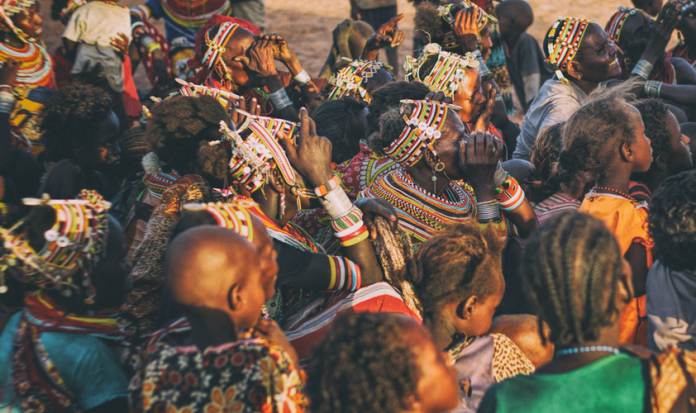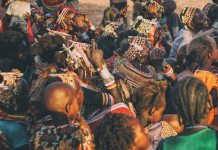This article is written by Ananya Pande and Simran Dhaner, students currently pursuing B.A.LLB(Hons.) from Hidayatullah National Law University. This is an exhaustive article which deals with the problems faced by the tribal people in our country and its repercussions. It also discusses the policies and schemes for resolving these problems.
“Grievances unspoken, burdens unprotested, destiny submitted’’
Table of Contents
Introduction
It’s a sad reality that tribals or Adivasis in our country are caught between two fires, neither they are able to totally depart from their old culture nor they are able to completely adapt to the new ones. This is the biggest Treason ever committed not only against them but to the whole of humanity. Tribals are the first-ever human social group that ever existed. There are multiple definitions given by scholars for the term ‘tribe’ and ‘tribal’ but some of the common features of these definitions would be common ancestors, ‘collection of families bearing a common name, speaking a common dialect, habitating a common territory etc. The tribal population in the country, as per 2011 census, is 10.43 crore, constituting about 8.61% of the total population. Madhya Pradesh has the largest number of Scheduled Tribes (STs) contributing 14.69% to the total percentage of ST population.
Overview
The tribal community is one of the most vulnerable community in India. Poverty, infringement of rights, poor healthcare and isolation are just some of the many hurdles in the life of the tribals. Many social thinkers like Jawaharlal Nehru and D. N. Majumdar have talked about them and has presented their views to handle this situation. Some other important problems pertaining to STs in India are identity crisis, reluctant urbanization, political absence, exploitation of resources, forced conversion-reconversion (Ghar Waapsi) and more. And responsibility of these treasons is on no one else’s but our shoulders. Yes, there is no particular individual to blame for this but us only. Not to mention these take a heavy toll on the tribal population and it’s the affect of this betrayal only that they are led towards Naxalism and other serious crimes, this is trespass of their culture and they are incapable of becoming a part of the mainstream.

Problems
Identity Crisis
It is seen from the inception of the modern era that the tribes have always been struggling to have their own unique identities but at more than one point of time it is seen that these identities are imposed on them. They are not a direct part of Hinduism but since our Constitution says that any person who is not a Muslim, Christian, Jew or Parsi will be considered a Hindu, so we refer to them as Hindus. If we look way back to the line of our ancestors, we’ll find that at some point of time we all belonged to some tribe and that was the inception. The Constitution of India refers to tribes as Scheduled Tribe and defines it under its Article 366(25). People think that Scheduled Tribes and Scheduled Castes have a little difference because both the terms have often been used together. This notion is completely wrong, as people fail to understand that the tribals do not belong to any caste and are not the SCs who were referred to as untouchables during the early period in India. Tribals are not any Jati but Janjati, not Dalits but Adivasis. They were never the part of the Varna Dharma of Hindus. They need to be identified properly, this crisis must end.
Reluctant Urbanisers
Due to globalization and industrialization in such a vast scale, there have been drastic changes in the lives of the tribal people. These all changes for the sake of development of the nation have led to the urbanisation and have made the tribal people reluctant urbaniser. They have a destitute standard of living and in the need of money they are forced to come out of their conventional living conditions. They are offered fanciful job opportunities as bait and they fall for it. They are trafficked or employed as sex workers, beggars and some are even subjected to sexual assault and forced surrogacy. They are forced to leave their native home in forests and become a part of the urban society where they feel out of the place. They are neither able to adapt to the urban society nor go back to their original habitat. They are stuck with no sense of belonging anymore.
Political Absence
We can very well question the existence of tribals in daily life, forget about them being represented politically. The tribals have always felt the lack of political representation, much needed in our country. They need some political leaders who can express the opinions of the tribes and put forth their demands and needs. They need representation so that their rights are not infringed and their issues get resolved through the judicial courts of the country. But we can very well see that there is a paucity of powerful political leaders who belong to tribal background and even those who are actually present are just there because there is a provision for reservation in our constitution. This representation should go beyond mere representation to fulfill the basic need of tribes.
Exploitation of Resources
With the loss of land and the natural surroundings, there has been a breakdown in traditional form of living and practices of tribals. The idea behind the exploitation of the tribal land is quite simple, these are the lands untouched and unexplored by anyone and hence are very rich in its mineral content. The whole 100% of the country’s tin is found in Dantewada of Chhattisgarh which is a tribal area. Their lands have been taken away for various developmental purposes due to which they have lost all their habitat and all means of livelihood. Their lands mined, forests curtailed, rivers poisoned, skies polluted. This is very unfortunate that the rights which our constitution vows to protect are manipulated for economic gains.
Ghar Waapsi
Ghar Waapsi which means ‘homecoming’, seeks to describe the coerced mass conversions to Hinduism. At first, they were forcefully converted to Christianity made to forget their “Bonga devta” for the love of Jesus by the English during British regime and then orthodox Hindus reconverted many of these poor tribals back to Hinduism. This is followed even today in India. An important example worth mentioning here would be the Ghar waapsi campaign led by Dilip Singh Judeo, which began more than two decades ago in undivided Madhya Pradesh, present day Jashpur, Chhattisgarh. It had often sparked controversies with organisers claiming to bring Christians ‘back to’ Hinduism which they said had been their original religion. It seems that they don’t even possess freedom of religion.
Repercussions of Treason
Naxalism
Term Naxalism is derived from the village Naxalbari in West Bengal. They are considered to be the far-left radical communists. It was a revolt against the landlords who bashed a peasant over a land dispute in West Bengal and slowly spread across other eastern states such as Chhattisgarh, Jharkhand, Andhra Pradesh and Odisha. From Tirupati to Pashupati. They are far radical and violent, and pose a threat to the nation. Redundant act of violence, land theft and other atrocities against tribals push them towards Naxalism and hence then they start to take up weapons and opt for violent measures. This terribly hampers the peace and harmony of the country in drastic ways. An important example worth mentioning here would be of ‘Salwa Judum’ (2005), meaning ‘Purification Hunt’. It was led by Mahendra Karma, the Tiger of Bastar, in the districts of Dantewada and Bastar. It was an armed militia that was a part anti-insurgency operation to counter naxalite violence in the region. Local tribals were raised against their own brethren resulting in a civil war. The Supreme Court outlawed and banned it, but it still exists in the form of Armed Auxiliary Forces, District Reserve Group and other vigilante groups working covertly.
Acculturation
With modernization and globalization in full swing, tribal culture comes in contact with other cultures of India due to which there is revolutionary change in tribal culture. Nowadays we see tribals in shirt-pants not with dhotis or peacock feather over their head or so on which used to be their traditional attire. The severe impact of this acculturation is that tribal people are abandoning their own long-run culture and traditions which is the heart and soul of a tribe. What is more disheartening is that nowadays their traditions and customs are not seen in their day-to-day life but merely during the festivals or national days through their traditional dance, cuisine and costumes. Culture for them is not merely a symbolic representation but a ‘way of life’.

Government Initiatives
Policies
Social thinkers discussed measures to be taken in their policies for upliftment of the tribal people keeping in mind what would be best for them. Firstly, the answer was Isolation. The creation of self-governing tribal areas with free power of self-determination with minimum or no interference at all. Secondly, the answer changed to Assimilation. The notion was that tribals are backward Hindus and they should be completely assimilated into Hindu culture only. To this D.N. Majumdar put forward his philosophy of tribal welfare. His view was that it is not possible to leave the entire tribal population to their own lot and also to completely assimilate them in the Hindu culture. Hence, a gradual transformation of the tribal population will be the best policy. We should help them in assimilating in their own way of life the elements of alien culture which they can readily accept. Finally, the answer was Integration. Jawaharlal Nehru in his Panchsheel policy formulated five principles for the policy to be pursued for their integration. They are:
- People should develop along the lines of their own genius, and the imposition of alien values should be avoided. Try to encourage in every way their own traditional arts and culture.
- The tribal rights in land and forest should be respected.
- Train and build up a team of their own people to do the work of administration and development. Try to avoid introducing too many outsiders into tribal territory.
- We should not over administer tribal areas or overwhelmed with a multiplicity of schemes. Administrate in accordance with their own social and cultural institutions.
- We should judge the result, not by statistics or the amount of money spent, but by the human character that is evolved.
Schemes and Programmes
A number of employment-oriented and developmental programmes for tribals have been introduced by the government of India. The major programmes are Jawahar Rosgar Yojana (JRY), Integrated Rural Development Programme (IRDP), Prime Ministers Rosgar Yojana (PMRY) and Training For Self Employment For Rural youth (TRYSEM). Also there have been several acts implemented for their benefit like Forest Rights Act (2006), Protection of Civil Rights Act (1955), SC/ST (Prevention of Atrocities) Act, Panchayats (Extension to Scheduled Areas) Act (1996) or PESA and others. The Ministry of Tribal Affairs drafted the National Tribal Policy in 2006 to look at the issue of development of STs in an integrated and holistic manner. It will address the issues such as enhancement of human development index of STs, improvement of infrastructure in STs dominated areas, ensuring that they have control over the natural resources base, displacement from their habitat and resettlement, distribution of wealth among tribals. The objective of this policy is to bring STs at par with the rest of the population in terms of their socio-economic conditions, HDI and basic infrastructure facilities in tribal areas. This policy can do wonders if implemented ideally.
Conclusion
Even after numbering so many issues of tribal people, we can still expect some good things for them in the near future as there are several schemes and programmes being implemented and laws even being amended to protect their rights and interests. There is not really a need of different set of rights and laws as in Tribal Rights for them, Human Rights are enough. But the real question is if we consider them humans or not.
References
https://www.mdpi.com/2077-1444/10/5/313/htm
http://www.journalijar.com/article/19014/understanding-the-indian-tribal-life-and-their-issues/
LawSikho has created a telegram group for exchanging legal knowledge, referrals and various opportunities. You can click on this link and join:
https://t.me/joinchat/J_0YrBa4IBSHdpuTfQO_sA
Follow us on Instagram and subscribe to our YouTube channel for more amazing legal content.
 Serato DJ Crack 2025Serato DJ PRO Crack
Serato DJ Crack 2025Serato DJ PRO Crack








 Allow notifications
Allow notifications



